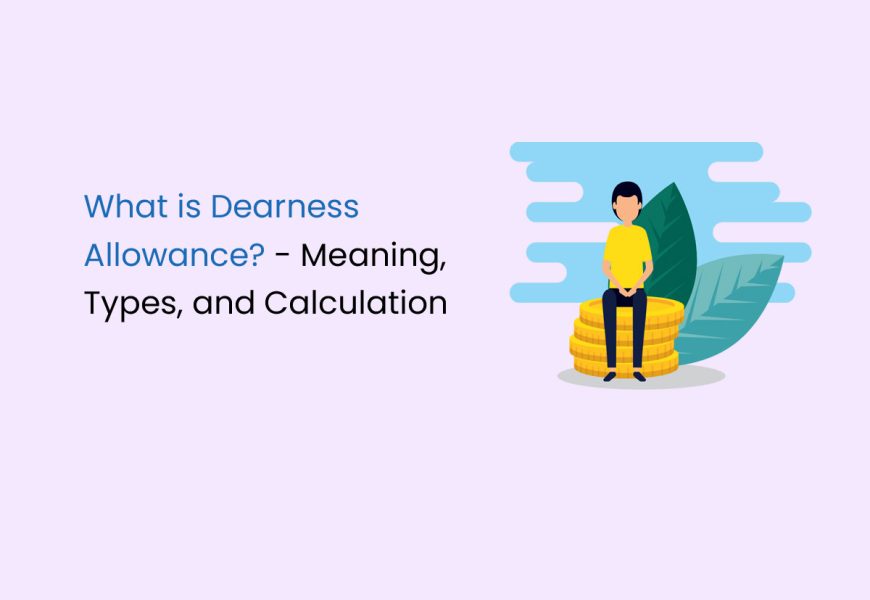Dearness Allowance (DA) serves as a crucial cost-of-living adjustment provided by the government to public sector employees and pensioners. Its primary purpose is to counteract the impact of inflation by being calculated as a percentage of the basic salary. Both India and Bangladesh extend this salary component to their employees.
Individuals must be aware of the tax implications related to DA, as per the guidelines outlined in the Income Tax Act of 1961. When filing Income Tax Returns (ITR), it is mandatory to declare the tax liability associated with Dearness Allowance.
This article talks about the significance of DA, shedding light on its role in the compensation structure, its calculation process, and the essential tax considerations for those receiving this allowance.
What is Dearness Allowance (DA)?
Dearness Allowance (DA) is a vital component of compensation provided by the Indian government to both its employees and pensioners, aiming to mitigate the impact of inflation on their financial well-being.
Unlike fixed salary components, DA is dynamic and varies among public sector employees, contingent on their geographical location. Distinct rates apply to individuals working in rural, urban, and semi-urban sectors.
The adjustment in DA rates occurs biannually, with the government revising them every six months. Changes typically take effect on January 1st for the period spanning January to June, and on July 1st for the duration from July to December.
Recent Developments as Per the Union Budget 2024
- In a noteworthy development, the Union Cabinet has sanctioned a 4% increase in Dearness Allowance (DA) for central government employees and pensioners, elevating it from 38% to 42%, effective from January 1, 2023.
- Several states, including Rajasthan, Madhya Pradesh, Assam, among others, have also increased DA by 4% for their respective state government employees and pensioners.
- The Department of Public Enterprises (DPE) under the Ministry of Finance has declared a hike in Dearness Allowance (DA) rates for employees of Central Public Sector Enterprises (CPSEs). This increase is applicable to individuals at Board level rank, below Board level rank, and non-unionised supervisors, adhering to the Industrial Dearness Allowance pattern of 1992 pay scales. The revised DA rates will be effective from July 1, 2023.
How Do You Calculate Dearness Allowance (DA)?
Dearness Allowance (DA) is a pivotal component in the remuneration structure for government employees, and its calculation underwent significant changes after 2006. The current formula for determining DA is as follows:
For Central Government Employees
For Central Public Sector Employees
Here, AICPI stands for All-India Consumer Price Index.
As an illustrative example, let’s assume your base income is Rs.33,000, and after a recent 4% increase, your DA percentage stands at 38%. This calculated dearness allowance, when applied to your base income, would amount to Rs.12,540. This example demonstrates the application of the formula in determining the dearness allowance for government employees, reflecting the intricate calculations involved in the compensation structure.
Types of Dearness Allowance
Dearness Allowance (DA) is a significant aspect of the salary structure for government employees, and there are distinct types of DA provided by the Indian Government. Let’s explore two prominent ones:
Variable Dearness Allowance (VAD)
Variable Dearness Allowance is allocated to Central Government employees and undergoes revision every six months. Its adjustment is contingent on changes in the Consumer Price Index (CPI), aiming to counteract the effects of inflation. VAD comprises three primary elements:
- Variable DA that remains fixed: This component maintains a fixed value until the government decides to alter the basic minimum wages.
- Base index: This index remains constant for a specified period.
- CPI: The Consumer Price Index, subject to monthly changes, influences the value of VAD.
The dynamic nature of VAD ensures that adjustments align with fluctuations in the cost of living, providing a mechanism to address inflationary impacts.
Industrial Dearness Allowance (IDA)
Industrial Dearness Allowance is extended to public sector employees by the Government, with revisions occurring every quarter based on changes in the Consumer Price Index (CPI). This allowance serves as a crucial component of the compensation structure for those employed in the public sector. The quarterly adjustments ensure that IDA remains attuned to the evolving economic landscape, fostering fairness and responsiveness to inflationary trends.
Understanding these distinct types of Dearness Allowance gives a better understanding of the tailored approaches employed by the Indian Government to address the diverse needs of Central Government and public sector employees in the face of economic fluctuations.
Effect of Dearness Allowance (DA) on Taxation
Dearness Allowance (DA) is a taxable component for salaried individuals, and it is essential to understand its treatment under income tax regulations. Here’s a concise overview:
- Taxation of Dearness Allowance: Dearness Allowance is subject to income tax. When calculating the total taxable income, DA is included as part of the salary. Salaried individuals are required to pay taxes on the entirety of their income, which encompasses the Dearness Allowance received.
- Treatment of Rent-Free, Unfurnished Housing: In cases where employees receive rent-free, unfurnished housing, the dearness allowance is considered part of the wage to the extent that it contributes to the retirement benefit salary. The taxable value of perquisites, including rent-free accommodation, is determined as per the prescribed rules under the Income Tax Act.
- Disclosure of Tax Liability: Individuals are obligated to disclose the tax liability associated with Dearness Allowance when filing their Income Tax Returns (ITR). The Income Tax Act mandates the accurate reporting of all income sources, including DA, to ensure compliance with tax regulations.
- Submission of Forms: Employers provide Form 16, which outlines the details of the salary, including Dearness Allowance, and the tax deducted at source (TDS). Employees must use this information when filing their income tax returns. They should accurately declare their Dearness Allowance and any other taxable components.
DA and HRA
Dearness Allowance (DA) and House Rent Allowance (HRA) are distinct components of an employee’s salary structure, each serving a different purpose and applicable to different sectors of employment. Let us look at the table carefully to understand their dissimilarities is crucial to avoid confusion and ensure accurate financial planning
| Basis of Comparison | Dearness Allowance | House Rent Allowance |
|---|---|---|
| Meaning | It is a cost-of-living adjustment offered to public sector employees by the Government. | It is a component of an employee’s salary that facilitates meeting accommodation rental requirements. |
| Applicability | Only public sector employees are eligible for DA. | Both public and private sector employees are eligible for House Rent Allowance. |
| Tax Exemptions | No tax exemptions are available for DA. | Certain exemptions apply to House Rent Allowance. |
| Calculation | DA is calculated as a percentage of the basic salary of a public sector employee. | House Rent Allowance (HRA) is not calculated as a percentage of the basic salary. |
Dearness Allowance Merger
Dearness Allowance Merger is a significant development that has garnered attention since 2006, as the dearness allowance for public sector employees has steadily increased, currently standing at 50% of the basic salary. This incremental rise has been a strategic response to mitigate the impact of rising inflation over the years.
Traditionally, when the dearness allowance percentage surpasses the 50% mark, it is a common practice to consider merging it with the basic salary. This potential merger holds the promise of substantial salary enhancement for employees, as various other components of the salary structure are often calculated as a percentage of the basic salary.
There has been persistent advocacy and demands from employees to merge Dearness Allowance with the basic salary. The union cabinet is currently under consideration to make a decision on this matter, adding an air of anticipation among public sector employees. The prospect of a merged Dearness Allowance is met with enthusiasm as it implies a significant salary boost for employees, fostering a positive outlook within the public sector workforce. The outcome of this decision is eagerly awaited and has the potential to bring about a notable positive impact on the financial well-being of public sector employees.
FAQs on Dearness Allowance
How often is Dearness Allowance (DA) revised for employees?
DA is reviewed every six months, biannually. This adjustment is based on changes in the cost-of-living index to ensure that employees' earnings align with the evolving economic conditions.
Which rule grants Dearness Allowance to pensioners and family pensioners?
Dearness Allowance for pensioners and family pensioners is granted under Pension Rule 50A. This rule addresses the need to compensate for the impact of inflation or the rise in prices over time.
Is Dearness Allowance applicable to private sector employees and pensioners?
No, Dearness Allowance is typically exclusive to public sector employees in India. Private sector employees and pensioners do not receive this component as part of their salary structure.
How is Dearness Allowance computed on pension?
Pensioner's Dearness Allowance is calculated based on the basic pension without commutation. It represents a specific percentage of the original pension, providing additional financial support to pensioners.
Does Dearness Allowance differ based on the work location of an employee?
Yes, Dearness Allowance varies for employees depending on their work location. This variation is due to the connection between DA and the cost of living, with different rates for rural, urban, and semi-urban areas.
When is the Dearness Allowance merged with the basic salary of an employee?
Dearness Allowance is merged with the basic salary when it exceeds 50%. This integration results in a significant salary boost for employees, enhancing their overall compensation.
Is Dearness Allowance taxable?
Yes, Dearness Allowance is taxable for salaried employees. It is considered part of their regular income, and individuals are required to declare the tax liability associated with DA during the filing of Income Tax Returns (ITR).
Do pensioners receive Dearness Allowance during reemployment?
Pensioners reemployed under certain conditions may not be eligible for Dearness Allowance, except in specific cases based on the nature of reemployment and associated terms.
Is Dearness Allowance granted to pensioners residing abroad?
Dearness Allowance is not granted to pensioners residing abroad during re-employment. However, pensioners living abroad without reemployment are eligible to receive Dearness Allowance on their pension, subject to applicable rules.





















